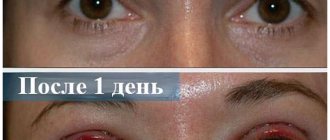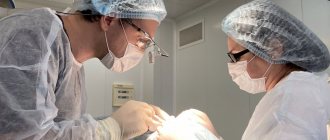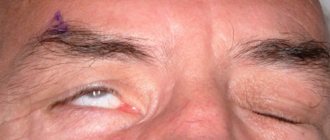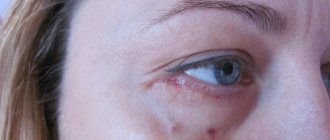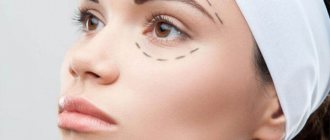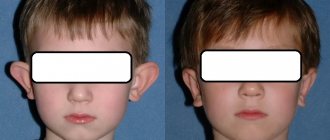Blepharoplasty is a serious plastic surgery with a pronounced rejuvenating effect. It will not be possible to see the final result immediately after the operation; to do this, you will have to wait until the rehabilitation period is over. In order for your eyes to quickly take on their attractive appearance, it is very important to seriously follow the doctor’s recommendations during the postoperative period.
For a better recovery, it is important to properly prepare for surgery. This means that you need to quit smoking and alcohol at least half a month before the procedure. You should also stop taking blood thinning medications. If you catch a cold or get sick immediately before plastic surgery, it is very important to inform your surgeon about this. He may decide to postpone the operation until the patient has fully recovered.
Features of sutures after blepharoplasty
Indications for blepharoplasty directly affect the surgical technique, location and size of the incisions.
Sutures after blepharoplasty of the upper eyelids are easily masked by the natural crease of the eyelid. They are almost invisible even in the early stages of postoperative recovery.
The stitches after lower blepharoplasty are located just below the edge of the eyelash line. After complete healing, traces of the incisions are not visible.
Circular (classic) blepharoplasty involves incisions and sutures in both the upper and lower eyelids.
When blepharoplasty is performed, the stitches after the operation are made with intradermal stitches, so they are completely invisible from the outside.
Sutures after blepharoplasty of the lower eyelids are not applied if the incision was made along the conjunctiva, i.e., from the inside (transconjunctival access). The mucous membrane heals faster than the skin, so there is no need to use threads. In addition, even absorbable suture material will severely injure the membrane of the eye when the eyeball moves.
Indications for blepharoplasty
Main indications for eyelid plastic surgery:
- loss of tone and elasticity of the skin of the eyelids;
- tired look (“heavy” eyelids);
- drooping skin of the upper eyelid (“drooping eyelid”, including congenital eyelid ptosis);
- drooping (ptosis) of the lower corners of the eyes, as a result of which their shape changes and the size of the eyes decreases;
- excess skin of the lower eyelids, wrinkles, hernias, folds of the lower eyelids.
An eyelid lift allows you to get rid of excess skin and fatty tissue in the eyelid area, reduce signs of age-related changes, eliminate congenital and acquired eyelid defects, and correct the muscles of the periorbital area.
Removing stitches after blepharoplasty
A question that interests every patient: if blepharoplasty was performed, how long does it take to remove the sutures? Healing time may vary. On average, stitches last from two days to a week. The duration of wearing is influenced by factors such as:
- patient's age;
- general health;
- turgor (elasticity, firmness) of the skin;
- smoking;
- alcohol consumption.
The procedure for removing sutures after blepharoplasty should not frighten the patient - it is almost painless. The suture is performed intradermally, i.e. the stitches are not visible from above. The ends of the thread are attached to the outer and inner corners of the eye with a special plaster - a strip.
When removing the fixing threads, the most painful moment is the detachment of the patch. The skin of the eyelids itself is sensitive, and in the postoperative period the sensitivity increases. After removing the patch, the end of the thread at the inner corner of the eye is cut short, and the surgeon removes the thread using the long end at the outer corner. At first a slight resistance is felt, but then the thread is easily pulled out. The sutures of the upper blepharoplasty are removed a little less painfully than the lower ones.
After performing blepharoplasty, the surgeon must inform the patient on what day the sutures will be removed. Usually you are invited to this procedure 2-5 days after the operation. The duration of wearing sutures is determined depending on the patient’s age, the fullness and general turgor of the facial skin. Thus, patients over 50 years old, especially those with a full face, are recommended to wear stitches for an average of 4-5 days. For patients under 40 years of age, the doctor may prescribe a removal procedure on the third day.
The process of removing sutures after blepharoplasty is greatly facilitated by absorbable threads, which disappear, dissolving in the patient’s tissues. The same intradermal suture is performed, which makes the junction of the tissues almost invisible after the swelling subsides.
It is important to understand that complete healing of the stitches after blepharoplasty and restoration of the skin will take approximately 12-16 weeks. After removal of the fixation, swelling, wrinkled skin, swelling, and hematomas (bruises) may be observed. These are completely normal phenomena, this is how the body reacts to the surgical intervention. A slightly red seam after blepharoplasty is also normal.
Recommendations to speed up rehabilitation
To quickly recover after blepharoplasty and achieve optimal surgical results, additional procedures are indicated:
- Massage of the skin around the eyes and eye gymnastics. They help improve blood circulation in the intervention area and strengthen the orbicularis oculi muscle. The surgeon who performed the operation will tell you when you can start these procedures, advise the correct massage technique, and show you exercises for the eyes.
- Physiotherapy. Microcurrent therapy is most often used, which normalizes lymph flow, eliminates swelling, and accelerates skin healing. Also shown are UHF and phonophoresis.
- Maintaining sufficient skin hydration. Cosmetic products should be used after scars have healed.
Treatment of sutures after blepharoplasty
The operating surgeon will tell you how to treat sutures after blepharoplasty. There are many drugs on the pharmaceutical market that accelerate the process of tissue regeneration. Also, these drugs promote the formation of smooth fusions of the skin of the eyelids, completely eliminating the possibility of the formation of rough scar tissue and so-called nodules.
Nodules are small lumps that can form during the healing process of a wound where the suture thread has penetrated.
Most often, home treatment of the wound is not required, since the junction is completely covered with a strip (plaster). The surgeon disinfects the wound immediately after the operation, so the likelihood of infection is extremely low. But if severe redness and soreness appear, then you should consult a doctor. There may have been an infection.
After the sutures are removed, ointments and gels can be prescribed to accelerate skin regeneration and prevent the formation of rough scar tissue. For example, Contractubex. Its use allows the healing process to proceed faster. After transconjunctival blepharoplasty, eye drops with a moisturizing effect (Artificial tear, Oftagel, Oftolik) can be prescribed. The drug is recommended by the surgeon and there is no need to select it yourself.
You can read a lot of advice on what to apply to your eyes after blepharoplasty on the forums. Patients willingly share information about the medications prescribed to them. But it is better to check with your doctor whether it is worth using this or that remedy.
Contraindications
Contraindications to blepharoplasty:
- difficult to correct dry eye syndrome;
- increased intraocular pressure;
- diseases of the cardiovascular system;
- diabetes;
- blood clotting disorder;
- acute viral diseases;
- acute infectious diseases (respiratory diseases, sore throat, pneumonia, etc.).
- diseases of internal organs (liver, kidneys, circulatory and endocrine systems, blood);
- chronic diseases in the acute stage.
Healing process
The healing process of sutures after blepharoplasty consists of several stages. The first period of wound healing occurs 2-7 days. At this time, it is necessary to fix the edges of the wound so that the fusion occurs as accurately as possible.
The second period is primary recovery, 2-4 weeks. During this time, the process of granulation occurs in the wound - new connective tissue of a rather bright pink color is formed. The patient should not be frightened or confused by the color, since granulation is only the second stage of healing. On the recommendation of a doctor, you can perform cosmetic procedures:
- lymphatic drainage;
- magnetic therapy;
- microcurrent therapy.
If during healing the patient notices that he is strongly pulling at the blepharoplasty sutures, then physical procedures are required. This will help get rid of unwanted consequences.
The third period is scarring. At this stage, ugly scars do not form. On the contrary, granulation tissue is replaced by epithelial tissue and the postoperative suture turns into a thin light pink strip, which is practically invisible in the natural crease of the eyelid. The duration of the third period is from 1 to 4 months. After this period, laser resurfacing of the seams and Botox injections can be performed. Laser resurfacing allows you to get rid of the cut line forever. Botox injections smooth out wrinkles that were not eliminated after eyelid surgery.
What blepharoplasty looks like: stitches, before and after photos.
Restrictions after surgery
Most prohibitions are temporary and must be adhered to until the end of the rehabilitation period (from 1-2 weeks to 1-2 months).
After blepharoplasty you cannot:
- expose your eyes to bright light and sunlight;
- allow excessive visual strain;
- experience physical activity, including active sports;
- lift weights;
- visit the bathhouse, sauna, solarium;
- rub your eyes;
- wear contact lenses;
- sleep face down or without a pillow;
- apply decorative cosmetics;
- try to remove stitches and healing crusts yourself;
- eat spicy, salty foods, smoked foods;
- smoking and drinking alcohol.
Subsequently, it is necessary to constantly apply a cream with a high sun protection factor to the skin around the eyes. Minimally invasive cosmetic procedures (Botox, mesotherapy) are allowed 2-3 months after surgery.
Scar Prevention
Following the recommendations of specialists will help to avoid unwanted manifestations in the form of proliferation of connective tissues and the formation of a keloid scar:
- do not rub or stretch the skin in the scar area;
- Until the incisions are completely healed, protect your eyes from ultraviolet radiation (sun, solarium);
- avoid physical activity;
- do not go to the sauna and bathhouse;
- When washing your hair and taking a shower, make sure that the water is not very hot, do not let it get on the seams;
- reduce the amount of salty foods so as not to provoke the formation of edema.
Pay attention to your doctor's advice and follow it strictly. Use ointments and other products that your specialist recommends to remove scars after blepharoplasty.
How can you smooth out scars?
The pressing question for patients is how and with what can they hide scars after blepharoplasty? Modern medicine offers several ways:
- Laser resurfacing. An innovative technique that is used in many clinics. When treating scars with laser, the risk of repeated tissue damage is eliminated. However, laser is not able to completely remove a scar; it only makes it invisible to others.
- Injections of steroids or immunomodulators. They are considered the most effective way to completely eliminate a scar. To achieve the desired effect, a course of treatment is carried out.
- Surgical intervention. Repeated surgery must be resorted to if serious complications arise in the form of rough scars with growths and bulges. Unfortunately, surgery to excise hardened tissue does not always give a positive result. In the practice of plastic surgeons, there have been cases when it led to an even greater proliferation of connective tissues and the formation of voluminous scars.
- Cryotherapy. This method involves treating scar tissue with liquid nitrogen, which has a very low temperature. The scar does not go away, but the seals disappear, the skin becomes lighter in color, and the scar merges with the entire skin.
Details of scar correction after blepharoplasty using injections can be found here:
The most competent way to prevent the formation of a keloid scar after blepharoplasty is the timely detection of its first signs. In the early stages, conservative treatment with ointments and physiotherapy is effective. If the negative process is started and time is lost, then the treatment will drag on for a long time, and in some cases the surgeon will have to intervene.
Possible complications
Blepharoplasty is known as an intervention with a minimal percentage of complications. However, some unpleasant consequences are still possible. Among them:
- hemorrhage in the sclera of the eye;
- hyperreaction to light;
- severe and prolonged lacrimation;
- inflammatory processes in the suture area;
- inflammation of the conjunctiva
- eversion of the century.
Sometimes these phenomena go away on their own; in some cases, medication is required. If, a few days after the operation, cutting pain, redness of the conjunctiva, an increase in previously minor symptoms, hyperemia or suppuration of the sutures, or an increase in body temperature appear, you should urgently contact the clinic where the intervention was performed.
Choosing a clinic and doctor with a good reputation, positive reviews, as well as following all the doctor’s recommendations in the pre- and postoperative period will help minimize the risk of complications.
Why do keloid scars form?
The appearance of keloid scars after blepharoplasty is a rare consequence of the operation. A negative symptom is formed due to excessive proliferation of connective tissues. The process of formation of a keloid scar looks like this:
- The appearance of dense areas of connective tissue in the 2nd week after surgery, accompanied by burning, pain and itching.
- Transformation of scar tissue into hard, raised areas with a smooth surface. At the site of the keloid scar, redness or paleness of the skin is noticeable.
- A sign of the formation of a keloid scar is an increase in the area of the suture compared to what it was immediately after the operation. Some patients experience growths above the scar.
Inevitable difficulties: swelling and bruising
The patient spends the first day after blepharoplasty in the clinic’s inpatient unit. In theory, you can return home on the day of surgery, but surgeons do not recommend doing this. Physician supervision immediately after surgery is very important in terms of minimizing the risk of complications and improving the aesthetic result of the correction.
The main difficulties for the patient are associated with the inevitable consequences of violation of the integrity of the integumentary tissues - swelling, pain and hematomas. After eyelid surgery, all these symptoms are present; the degree of their severity depends on the specifics of the surgical intervention, the age of the patient, and the individual reaction of the body.
To reduce the symptoms mentioned above, the plastic surgeon prescribes anti-inflammatory drugs. To reduce swelling, cold compresses can be applied to the eyelids on the third or fourth day after the procedure. A course of antibiotics is indicated to prevent infection. It is important to regularly put antiseptic drops into your eyes. You only need to wash your face with boiled water or herbal decoctions, such as chamomile.
A specific symptom of the rehabilitation period after blepharoplasty is dryness of the conjunctiva and a feeling of “sand” in the eyes. Some patients face the opposite problem and complain of increased tearing. These consequences do not pose a threat to health, but measures must be taken to help normalize the functioning of the lacrimal glands.
To speed up recovery after blepharoplasty, it is necessary to minimize the load on the visual analyzer. Try not to read, watch less TV, limit the time you work with a computer or smartphone. If possible, avoid rooms with bright lighting. At home, turn on dim lights.
External remedies for scar healing
The pharmaceutical industry produces a range of creams and gels that actively affect epidermal cells, which can significantly reduce the severity of scars after operations. The Contratubeks gel, which is capable of dissolving rough tissue and smoothing scars, has earned a good assessment from experts. Doctors recommend using it as soon as the stitches are removed. In addition, you can use other external preparations:
- Dermatix gel - has a high softening effect, prevents tissue hardening, smoothes out uneven scars.
- Zeraderm accelerates recovery processes, improves blood flow, and nourishes skin cells with oxygen.
- Kelofibrase prevents inflammation of scars and normalizes the water balance of the skin.
- Scarguard – forming a protective film, retains moisture, prevents tissue from drying out, softens scars.
Consult with your doctor about the choice of external scar smoothing agent. Some components of creams and gels can cause allergies and irritation.
